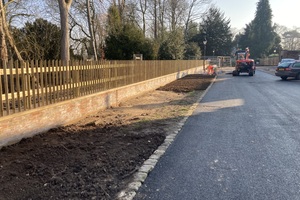Work to reduce flood risk in Bishopthorpe now complete
Press release
The Environment Agency has completed work on a £3.4m project in the village of Bishopthorpe in York, better protecting 198 properties from the risk of flooding.

Completed flood defence wall in Bishopthorpe
Work on the scheme started in May 2021 to construct a 180 metre flood defence wall running along Chantry Lane and the boundary of the Bishopthorpe Palace grounds, incorporating a six metre-deep steel barrier underground; a floodgate across the bottom of Chantry Lane and water flow mechanism to prevent river water from backing up into the drainage system.
Flood gate being installed at Bishopthorpe
The scheme also protects properties on Main Street, therefore helping to protect access for residents in the village.
In addition, 50 trees have been planted locally, with plans in place for over a hundred more and hedging to compensate for the 18 trees which had to be removed to build the flood wall.
Chris Ashcroft at the Environment Agency said:
The recent flooding in Yorkshire highlights the importance of projects like this one in Bishopthorpe, which will help make York more resilient to climate change and better protect 2,000 homes and businesses from flooding. We would like to thank residents for their patience and cooperation while we have been building these vital community flood defences.
This work forms part of the £45 million York Flood Alleviation Scheme, which is made up of 18 smaller ‘cells’ like this one.
Last year, a record £5.2 billion government investment to create around 2,000 new flood and coastal defences and better protect 336,000 properties across England was announced.
Over £146 million has been allocated in 2021-22 to 150 flood schemes across Yorkshire.
The construction of flood defences are just one of the tactics that can be deployed to protect people and property. Residents are urged to sign up for free flood warnings to get vital time to save themselves and their possessions from the devastating effects of flooding by visiting www.gov.uk/flood or contacting Floodline on 0345 988 1188.
They can also check their flood risk online at https://www.gov.uk/check-flood-risk.
Published 16 March 2022
